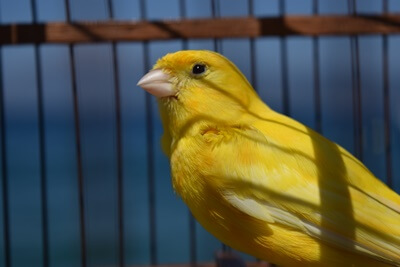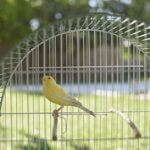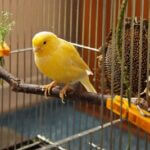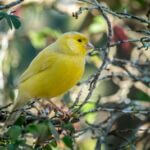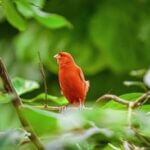You might want to own a canary as a pet, enjoying its companionship, beautiful songs, and eye-catching colors. Alternatively, you may want a canary for breeding or showing.
All canaries share similar traits, especially regarding temperament. However, they have various colors, singing abilities, and sizes.
There are 200+ different species of canaries found in the wild. It helps to know the different canaries kept as pets to decide which one is right for you.
What Are Canaries Like As Pets?
Canaries are small birds that are suitable for beginner and experienced owners. Because they aren’t social animals, they don’t require hours of human company or species-specific companions.
That said, not all canaries are the same. Their colors can vary widely, and the quality and complexity of their songs are species-specific.
Vocalizations
Song canaries are bred for their melodious singing, and males are better singers than females.
According to a Journal of the Acoustical Society of America, male canaries have evolved to sing better to attract mates. Complex songs also establish dominance in their limited social groups.
Canaries are quieter than most other birds. Their songs and different vocalizations are lower in volume, and canaries never scream unless they’re frightened or highly stressed.
Personality
Canaries prefer to spend time alone and dislike handling. However, their cheerful disposition and laid-back personalities make them fun pets.
They don’t dance or cuddle, but they like to sing with their owners, listen to music, and (when well-trained) perch on your hand or finger for attention.
However, canaries are timid around unfamiliar faces and can be startled easily.
Bad Habits
Males, in particular, are possessive over their mating partners and aggressive toward each other.
For this reason, they should be kept in separate cages. If you decide to place them in a single cage, ensure that it’s spacious and that more females are present than males.
Types of Pet Canaries
Here are the most popular types of pet canaries:
1/ Border Canary
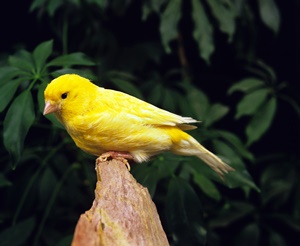
The border canary, also known as border fancy or common canary, is arguably the most ubiquitous species.
This tiny songbird is native to Europe but has spread across many parts of the world over the centuries. It’s currently one of the most common species found in pet stores.
Members of this species are recognizable by their short, stocky bodies, which measure about 10-12 cm at their full size.
They also have small round heads, sharp eyes, and tiny beaks. While most border fancies have solid-yellow plumage, they can be bred to produce other color variations, including:
- White
- Green
- Cinnamon
- Blue-yellow
Border canaries may be kept in indoor cages and outdoor aviaries. However, if you decide to keep them outdoors, ensure the aviary is properly sealed to protect against cold and wet weather.
2/ American Singer Canary
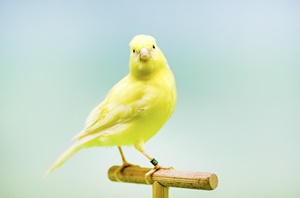
The American singer canary is a cross between the border canary and the German roller, the latter of which is a domestic songbird that was first bred in the Hartz Mountain Region of Germany during the 1800s.
They’re prized for their sophisticated songs, which they produce with closed mouths. This creates a less shrill and more pleasant song when compared to other canary species.
First bred in the 1930s, the American singer canary has become a popular pet in U.S. households and a sought-after bird worldwide. While it has a small, compact body like the common canary, the American singer is much larger, with the average adult measuring 15 cm.
This variety has a wide range of vibrant colors, including blue, yellow, green, white, and orange.
Although most American singers have plumage of single, solid colors, others grow different color tones and patterns. Even so, yellow and orange birds remain the most popular colors, as their traditional appearance appeals to many canary enthusiasts.
Personality-wise, American singers are friendly pets that make great companions for adults and kids. They enjoy interacting with their owners and other birds, faring well in a shared cage. Nevertheless, males can be domineering and aggressive toward other males, so keep males in separate cages.
Unlike other canary species, the American singer is resilient and adapts well to different environments. As long as you provide one with ample living space, light, and a quality diet, it’ll stay healthy and content.
3/ Crested Canary
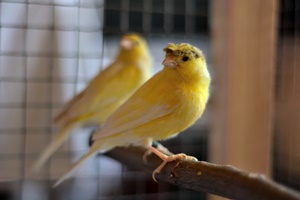
The crested canary is a breed predominantly kept for its physical characteristics, specifically, the tuft of feathers on its head, known as the “crest.”
They typically have short, stocky bodies, stout necks, and more feathers than other species. Their plumage varies in color from yellow, orange, and cinnamon to frost, white, and gray.
Moreover, crested canaries are good-natured pets that thrive well in single or shared cages and aviaries with other birds. However, since they’re relatively timid, they shouldn’t be housed with naturally aggressive birds, such as budgies, hookbills, and lovebirds.
The best candidates for pairing in a flock include other finches, hardbills, and doves.
4/ Gloster Canary
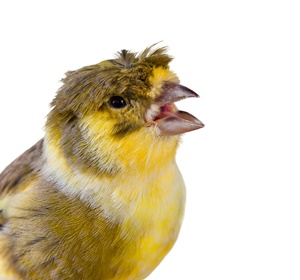
The Gloster canary is an iconic breed due to its physical appearance rather than its colors or singing ability.
This variety is instantly recognizable by the tuft of feathers on its head, which gives it a “bowl-cut” look. It has a short round body and measures about 12-15 cm when fully grown.
Unlike other canary types, the Gloster canary doesn’t naturally occur in the wild. Instead, it has been developed through selective breeding since the late 19th century.
The Gloster canary is also an excellent songbird, capable of producing melodious songs. However, it’s quieter than other song canaries, making it an ideal pet for an apartment.
5/ Fife Fancy Canary
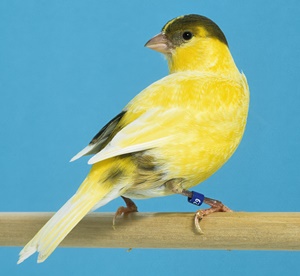
The Fife fancy canary is a miniature variant of the border canary and is thought to be the smallest breed available. Its tiny size, lively personality, and minimal care requirements make it a great pet for beginners and children.
Fife fancy canaries originate from Fife in Scotland, where they were first bred for their cuteness in the mid-20th century. Thanks to selective breeding over the years, they’re available today in a wide range of colors, including:
- Yellow
- White
- Blue
- Cinnamon
- Green
These are often paired with different color combinations and plumage patterns.
6/ Frilled Canary
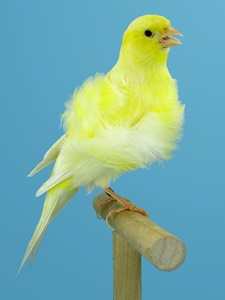
Frilled canaries refer to a variety of canaries bred for their ornate appearance, particularly the unique arrangement of their feathers. They have fluffy and frill feathers on their chests, backs, and flanks, which give them a naturally unkempt look.
The unique frilled appearance of these canaries derives from a genetic mutation that occurred in the Dutch breeds in the 19th century. However, different types of frilled canaries develop different patterns, volumes, and densities of frills in their feathers.
They also come in many color variations, including dominant white with green or yellow hues, brown and variegated.
Popular sub-breeds of frilled canaries include the following:
- Swiss frill
- French frill
- Hunchback frill
- Italian frill
- Japanese frill
7/ Red-Factor Canary
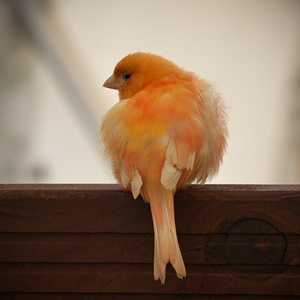
The red-factor canary is among the most loved canaries in the world. It’s instantly recognizable by its visually-striking plumage, which ranges in color from deep orange-red and copper to apricot, pink, and bronze.
According to Current Biology, red-factor canaries are bred by crossing red siskins with common yellow canaries. However, modern breeders can produce these birds by selectively breeding canaries that possess the red-factor gene. So, red siskins are no longer required to breed red-factor canaries.
To maintain their vibrant red color, they must be fed foods rich in carotenoids, particularly when growing new feathers during a molt, a practice known as color feeding.
The best foods to help maintain the red plumage include;
- Carrots
- Cherries
- Beets
- Broccoli
- Kale
Aside from these special dietary requirements, general care and maintenance for red-factor canaries are similar to other canary breeds.
8/ Lizard Canary
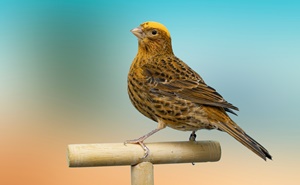
The lizard canary is one of the oldest breeds, dating back to the early 18th century. It’s known for the beautiful black crescent markings on its back and chest, which give it a “scaly” appearance, similar to lizards. However, they usually lose this lizard-like feather pattern yearly during molting.
Lizard canaries come in silver, red, blue, and gold. Like red-factor canaries, lizard canaries are often fed diets rich in beta-carotene to enhance the color of their plumage. However, this is only necessary when molting, as they shed their old feathers and grow new ones.
Lizard canaries are more social, so they can thrive in the company of other birds. However, you must ensure your aviary is spacious enough, as they can be territorial. That makes it wise to keep them in single cages or pair them up for optimal cohabitation, especially during the breeding season.
How Much Do Canaries Cost?
The pricing of a canary will vary widely, based on factors like:
- Seller
- Species
- Pedigree
- Coloring
- Singing abilities
- Size
- Age
- Health
Here are the average prices of popular pet canaries:
| Canary Breed | Average Price |
| Border Canary | $50 – $150 |
| American Singer Canary | $100 |
| Crested Canary | $100 |
| Gloster Canary | $100 |
| Fife Fancy Canary | $50- $150 |
| Frilled Canary | $120 |
| Red-factor Canary | $50 – $150 |
| Lizard Canary | $50 – $150 |
The most important price factor is the canary’s gender because males have excellent singing abilities, while females typically don’t.
Then, the price is based on the precise coloring of the canary you’ve selected. The rarer its color is (which may include color combinations and unique patterns), the higher the price tag.
The type of plumage can also influence the cost. Canaries with crests, such as Gloster and crested canaries, often fetch top dollar compared to plain-headed types.
As long as you can find a reputable vendor that sells healthy canaries (usually with documentation), you should be able to purchase a canary at a fair price for its unique traits.

